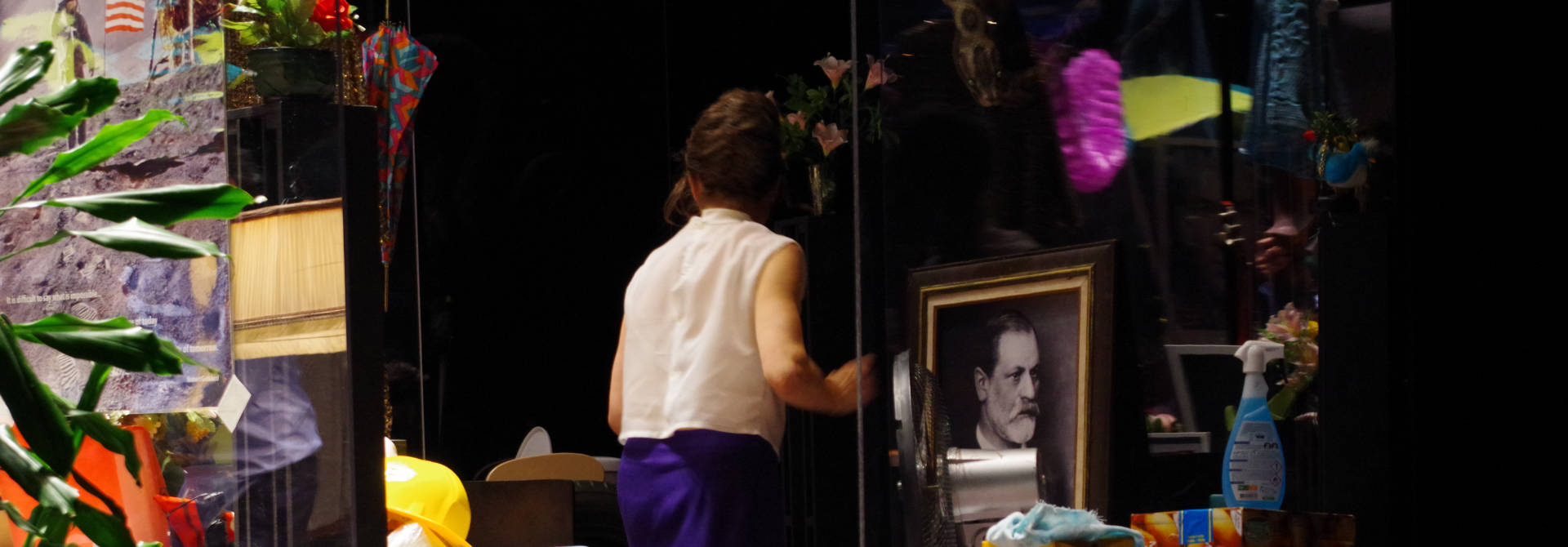
Ligne de crête (2018)
“What has happened to people’s desire?” 1
Stifled and entangled in a knot made up of the many torments of our times: social violence, the frenzy of mercantile desire, economic and political structures that are more and more opaque, blaring injustice, wars, the dead and the drowned, disenchanted hope, resignation and feelings of impotence, withdrawal into oneself and “pampered bodies”… This simple question is an invitation into a web of obstacles and opens up the possibility for profound reflection upon something that is in fact of essential interest for each of us in regards to our own existence and may hinder our collective desire for social transformation. To remain standing and step by step walk the line between two dangerous slopes, between the violence of dysfunctional institutions and the violence of the passions of man – “as they are and not how they wish they were” 2 – opens up our inclination to perceive, feel, act and think in a certain way, interiorised and incarnated by each individual through varying affects – “to renounce what we’ve learned to love” 3. This is the effort we must exert in order to rediscover our capacity to reconstruct a regime of desire that is different from the one that has been patiently instituted by capitalism and its infamous offspring neoliberalism. It is a process of liberation. The origin of this present work, Ligne de crête 4 , is rooted in the unconventional combination Frédéric Lordon proposed in his book Willing Slaves of Capital, which examines the passions of Spinoza’s philosophy and the political philosophy of Marx.
Accompanied by six artists- performers, I wish to further engage with this particular subject matter, something we began treating in our precedent piece, DEUX MILLE DIX SEPT. This time our intention is to tackle it from another angle, like mad rock climbers who, with much endurance, radically change their positions of attack and thus discover unexplored paths as they attempt to reach a perhaps unattainable summit. In the post script following the text from his piece D’un retournement l’autre, Frédéric Lordon cites both Spinoza and Bourdieu – real ideas do not possess intrinsic force – further affirming that “it is art that constitutively disposes the means to affect, through its initial address to the bodies to whom it proposes its affects: through image and sound.” This is not to say that the primary concern of art is to convey ideas – it can, and must, conceive itself as a mode of production of intransitive affections, as understood in Deleuze’s precepts. It may also wish to say something. Although this form of art was much appreciated in the second half of the 20th century, it has since fallen out of favour to such a degree that “engaged art” has almost become a derisive label for what we perceive as inordinately significant intentions, over-deliberated objectives and the irritating function of duty. We may have many grievances with “art that has something to say” – and yet the problem is no less comprehensive when considered from another angle, because sitting opposite art that “has something to say” are all the many things waiting to be said. These things have an imperious need for affect and with the refluence of “political art” as such, the things- to-be-said risk being left unexpressed or rather to remain in diminished vitality or in a debilitated state of pure analysis. If there is a need for affect, who will furnish it? Affect is necessary if something is to become compelling, in other words endowed with the power to affect; an indispensible condition for efficaciously penetrating people’s minds, accessing their bodies and producing certain effects. Effects in this case may be understood in terms of movement: accelerated heart-rhythm, arterial tension, choleric agitation and eventually the uncrossing of legs, i.e. action toward movement, locomotion that leads towards participation, entry into the assembly and perhaps in the end, getting out on the street. Against the inert advantages of domination, all is conceivable, whatever the means: film, both fiction and documentary, literature, photography, comic books, installations – all these forms may be considered for the construction of affecting machines. Theatre as well.
1 Question posed by Frédéric London during a conference entitled “Beyond Capitalism”.
2 Baruch Spinoza -Theological-Political Treatise.
3Taken from a conference given by Frédéric Lordon “Beyond Capitalism”.
4 Ligne de crête – A geographic and geological concept, it literally translates to ridgeline in English.
CREDITS
a play for 7 performers in collaboration and with Ulises Alvarez, Laura Frigato, Françoise Leick, Louise Mariotte, Cathy Polo, Ennio Sammarco, Marcelo Sepulveda
conception: Maguy Marin
lighting design: Alexandre Béneteaud
set design & sound design: Charlie Aubry
sound manager: Chloé Barbe
stage manager: Balyam Ballabeni
costume design: Nelly Geyres
trainee: Lise Messina
Coproduction:
Biennale de la Danse de Lyon Théâtre de la Ville Théâtre Gérard Philippe, Centre dramatique national de Saint-Denis, La Briqueterie-CDCN du Val-de-Marne, Ville de Fontenay-sous-Bois, théâtre Garonne, scène européenne – Toulouse ThéâtredelaCité – Théâtre national de Toulouse La Place de la Danse – CDCN Toulouse – Occitanie. With the support of Conseil Départemental du Val de Marne for help with creation
La Compagnie Maguy Marin with national and international influence is supported by Ministère de la Culture et de la Communication (Direction générale de la création artistique Délégation à la Danse).
La Compagnie Maguy Marin is subsidized by la Ville de Lyon, la Région Auvergne-Rhône-Alpes et reçoit l’aide de l’Institut français for his projects abroad.
Photo: Loli Hidalgo
